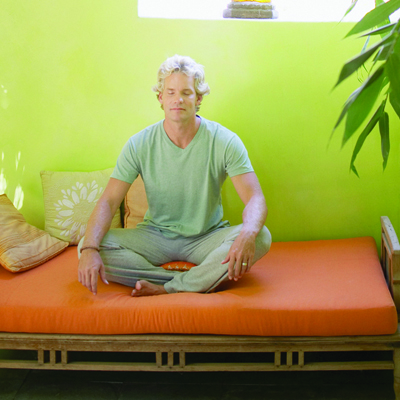Meditation: An Ancient Practice Soothes Modern Stress

Why do people meditate? In today’s fast-paced world, one obvious reason for seeking mental peace is simply the need to decrease the effects of stress. Stress contributes to high blood pressure, heart disease, digestive issues, obesity, insomnia, and more.
When faced with a perceived threat (whether it be money problems, deadlines, traffic, or a cranky spouse), the human body responds with an increased pulse rate and stress hormones flooding to the bloodstream. These ingrained reactions are great if you have to kill a woolly mammoth for dinner, but the fight-or-flight response isn’t particularly helpful when you need to lead a meeting, drive on I-90, or have a rational conversation.
A regular meditation practice can help you keep your stressors in check, especially the ones that are fed by a frantic, overactive imagination. The goal is simply to remain in the present moment. Sounds simple, but it might be tricky the first few times you try it.
Here are a few pointers to get you started:
- Commit to a formal practice by setting aside a time and place in your home to meditate. Decorating your meditation corner with candles, plants, or meaningful artwork may help you set the tone. You will also need a comfortable cushion, mat, or chair.
- Assure that you will not be disturbed by texts, calls, emails, or family obligations. Getting up a half-hour earlier than usual can help you achieve this. Early morning is a great time to practice.
- Start by focusing on the breath, observing each inhalation and exhalation. Deep, relaxed breathing will slow your heart rate.
- Doing some gentle yoga or stretching can also help you Close your eyes as you do this, bringing your attention inward and feeling your body relax.
- Sit or lie, comfortably supported. Once the mind quiets, bring your attention to the toes and feet. Tense the muscles and then relax them, shaking off any unnecessary holding. Slowly move your focus up through the ankles, legs, hips, stomach, back, chest, shoulders, arms, neck, and head, releasing tension from each part.
- Continue to bring your focus back to the breath. Thoughts will arise, but put them aside. You don’t need to pursue them now.
- If holding your eyes closed is difficult, keep them open but maintain a still, unfocused gaze instead of glancing around the room. For some, looking at a candle flame is a good way to settle the mind.
- Focusing on an intention may be a useful tool. For example, you could begin by wishing yourself happiness and health, then wishing the same for those you love and all living beings.
- Field trip! For a change of pace, try walking meditation. This can be as easy as putting one foot in front of the other (preferably in a safe and traffic-free area), being mindful and breathing deeply as you go. There are also many places that invite you walk through labyrinths designed to help you quiet a distracted mind.
- Stick with your practice. It will get easier. Don’t stress about it or worry that you aren’t doing it right. It’s a very personal thing and you just have to do the best you can each time.
- There are hundreds of helpful books about this topic. Two good choices for beginners are: Wherever You Go, There You Are, by John Kabat-Zinn and How to Meditate: Making Friends With Your Mind, by Pema Chodron.
- Finally, practice gratitude for all that you have. Most of all, thank yourself for taking the time to be fully present in the moment. Done faithfully, your meditation practice will lead you on a mindful path to better health, deeper sleep, calmer days, and a brighter outlook.
 The Daily Dose
The Daily Dose
2 Responses to “Meditation: An Ancient Practice Soothes Modern Stress”